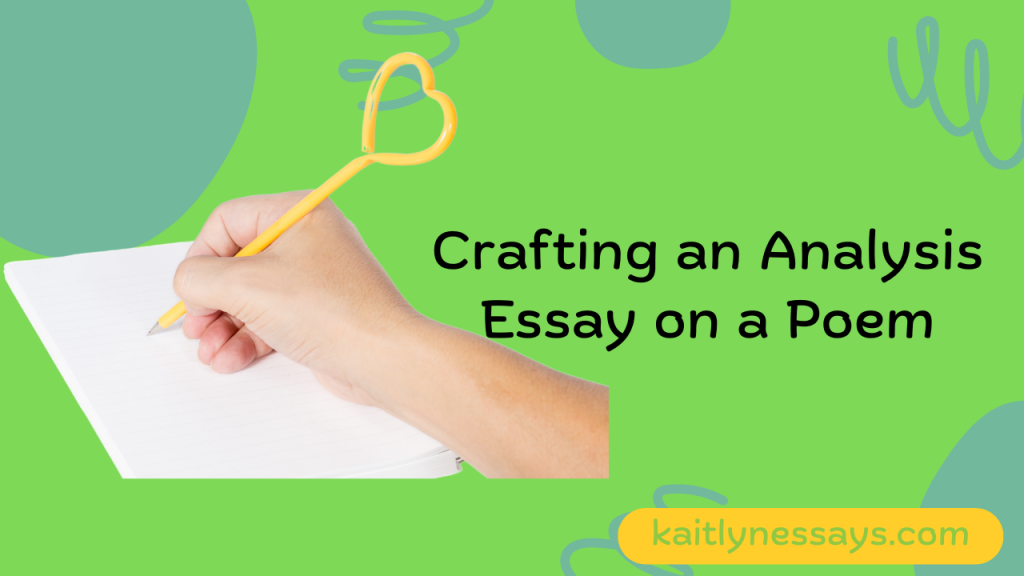
Poetry has been a medium of expression for centuries, captivating audiences with its lyrical beauty and profound meanings. Analyzing a poem allows readers to delve deeper into its layers of symbolism, imagery, and themes, unraveling the poet’s intended message. Writing an analysis essay on a poem requires a keen understanding of poetic devices, literary elements, and the ability to interpret the text critically. In this essay, we will explore the step-by-step process of crafting a compelling analysis essay on a poem, from selecting the right poem to dissecting its nuances and crafting a well-structured essay.
Writing an Analysis Essay on a Poem

1. Selecting the Poem
The first step in writing an analysis essay on a poem is selecting the right poem to analyze. When choosing a poem, consider the following factors:
- Relevance: Select a poem that resonates with you or addresses themes and subjects that interest you. Analyzing a poem that you are passionate about will make the process more engaging and enjoyable.
- Complexity: Opt for a poem that offers depth and complexity, with rich imagery, metaphorical language, and multiple layers of meaning. A complex poem provides ample material for analysis and interpretation.
- Accessibility: While choosing a challenging poem can be rewarding, ensure that it is accessible enough for thorough analysis. Avoid overly obscure or cryptic poems that may hinder understanding.
Once you have selected a poem, read it multiple times to familiarize yourself with its content, structure, and poetic devices.
2. Understanding Poetic Devices and Literary Elements
Before diving into analysis, it is essential to understand the various poetic devices and literary elements commonly found in poetry. These include:
- Imagery: The use of vivid and sensory language to create mental images and evoke emotions.
- Metaphor and Simile: Figurative language that compares two unrelated things, often used to convey abstract concepts or emotions.
- Symbolism: The use of symbols to represent ideas, themes, or concepts beyond their literal meaning.
- Tone and Mood: The emotional atmosphere created by the poet through word choice, imagery, and rhythm.
- Structure and Form: The organization and arrangement of lines, stanzas, and rhyme schemes within the poem.
Familiarizing yourself with these poetic devices and literary elements will enable you to identify and analyze them effectively in the chosen poem.
3. Conducting Close Reading
Close reading is a fundamental technique used in literary analysis to examine a text closely and uncover its deeper meanings. When conducting a close reading of a poem, pay attention to the following aspects:
- Title: Analyze the title of the poem for clues about its subject, theme, or tone.
- Language and Diction: Examine the poet’s choice of words, their connotations, and their impact on the overall meaning of the poem.
- Imagery and Figurative Language: Identify and analyze the use of imagery, metaphor, simile, and other figurative language employed by the poet.
- Sound and Rhythm: Consider the poem’s rhythm, meter, rhyme scheme, and sound devices such as alliteration, assonance, and consonance.
- Themes and Motifs: Explore the recurring themes, motifs, and symbols within the poem and their significance.
- Narrative Voice: Consider the perspective from which the poem is written and its effect on the reader’s interpretation.
By closely examining these elements, you can uncover the deeper layers of meaning embedded within the poem and develop insights for your analysis.
4. Formulating a Thesis Statement

A thesis statement is a central argument or claim that you will support and develop throughout your analysis essay. When formulating a thesis statement for a poem analysis, consider the following:
- Interpretation: Offer a clear interpretation of the poem’s meaning, focusing on its themes, symbols, and literary devices.
- Analysis: Identify the specific elements of the poem that you will analyze in support of your interpretation.
- Significance: Explain why the poem is worth analyzing and what insights or revelations it offers to readers.
A strong thesis statement provides a roadmap for your analysis and guides the reader’s understanding of your interpretation of the poem.
5. Crafting the Essay Structure
An effective analysis essay on a poem follows a structured approach that allows for a coherent and organized presentation of ideas. Consider the following structure for your essay:
- Introduction: Begin with an engaging introduction that provides context for the poem, introduces the poet and title, and presents your thesis statement.
- Body Paragraphs: Develop your analysis in the body paragraphs, with each paragraph focusing on a specific aspect or element of the poem. Provide textual evidence, quotes, and examples to support your analysis and interpretation.
- Conclusion: Summarize your main points, restate your thesis, and offer final insights or reflections on the poem’s significance.
Ensure that each paragraph in the body of the essay follows a clear and logical structure, with a topic sentence, supporting evidence, and analysis.
6. Incorporating Textual Evidence and Citations
Support your analysis with textual evidence from the poem, including direct quotes, paraphrases, and references to specific lines or stanzas. When citing textual evidence, follow the MLA (Modern Language Association) citation style guidelines, including in-text citations and a works cited page.
For example, if analyzing Robert Frost’s poem “The Road Not Taken,” you might incorporate textual evidence as follows:
“In the final stanza of ‘The Road Not Taken,’ Frost writes, ‘I shall be telling this with a sigh / Somewhere ages and ages hence’ (lines 16-17). Here, the use of the word ‘sigh’ suggests a sense of regret or nostalgia for the path not chosen, underscoring the theme of individual choice and its consequences.”
Ensure that all quotes and paraphrases are properly cited, with page numbers or line numbers included for poetry.
7. Revision and Proofreading
Once you have drafted your analysis essay, take time to revise and proofread it carefully. Pay attention to the following aspects:
- Clarity and Coherence: Ensure that your ideas are presented clearly and logically, with smooth transitions between paragraphs and sections.
- Grammar and Mechanics: Check for grammatical errors, punctuation mistakes, and spelling errors.
- Style and Tone: Maintain a formal and academic tone throughout the essay, avoiding colloquial language or slang.
- Accuracy: Verify the accuracy of your analysis and interpretation, and make any necessary revisions or clarifications.
Consider seeking feedback from peers, professors, or writing tutors to gain insights and perspectives for improving your essay.
Conclusion
Crafting an analysis essay on a poem requires careful attention to detail, critical thinking, and literary analysis skills. By selecting the right poem, understanding poetic devices and literary elements, conducting close reading, formulating a strong thesis statement, and crafting a well-structured essay, you can unlock the rich layers of meaning and imagery within the poem. Remember to support your analysis with textual evidence and citations, and revise your essay thoroughly to ensure clarity, coherence, and accuracy. Through the process of analyzing a poem, you can gain deeper insights into the complexities of language, imagery, and human experience, enriching your appreciation of poetry as an art form.
Having difficulty expressing your ideas in writing? We are here to help. We specialize in offering high-quality academic writing services, ensuring that your paper is not only well-written but also demonstrates a thorough understanding of the subject. With our experienced professionals assisting you, you can transform any challenging topic into a finely crafted masterpiece.
FAQs
What is an analysis essay on a poem?
An analysis essay on a poem is a type of literary analysis that examines a poem closely, exploring its themes, imagery, poetic devices, and deeper meanings. It involves interpreting the poem’s content and structure to uncover the poet’s intended message and significance.
How do I choose a poem to analyze?
When selecting a poem to analyze, consider factors such as relevance, complexity, and accessibility. Choose a poem that resonates with you, offers depth and complexity, and is accessible enough for thorough analysis. Pay attention to themes, imagery, and literary devices that interest you.
What are some common poetic devices and literary elements to analyze in a poem?
Common poetic devices and literary elements to analyze in a poem include imagery, metaphor and simile, symbolism, tone and mood, structure and form, and narrative voice. These elements contribute to the overall meaning and impact of the poem.
How do I incorporate textual evidence from the poem into my analysis essay?
When incorporating textual evidence from the poem into your analysis essay, use direct quotes, paraphrases, and references to specific lines or stanzas to support your analysis. Follow the MLA citation style guidelines for citing poetry, including in-text citations with page numbers or line numbers.
What is the structure of an analysis essay on a poem?
An analysis essay on a poem typically follows a structured approach, including an introduction, body paragraphs, and a conclusion. The introduction provides context for the poem and presents the thesis statement. Body paragraphs develop the analysis with supporting evidence and analysis of specific elements of the poem. The conclusion summarizes key points and restates the thesis.
How do I revise and proofread my analysis essay on a poem?
To revise and proofread your analysis essay on a poem, focus on clarity, coherence, grammar, mechanics, style, tone, and accuracy. Ensure that your ideas are presented clearly and logically, with smooth transitions between paragraphs. Check for grammatical errors, punctuation mistakes, and spelling errors. Maintain a formal and academic tone throughout the essay, and verify the accuracy of your analysis and interpretation.
Where can I find additional resources for writing an analysis essay on a poem?
Additional resources for writing an analysis essay on a poem include online databases, academic journals, literary criticism, writing guides, and writing centers. You can also seek guidance from professors, peers, or writing tutors for feedback and assistance with your analysis essay.
Reference
Frost, Robert. “The Road Not Taken.” Poetry Foundation, www.poetryfoundation.org/poems/44272/the-road-not-taken.
